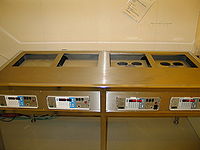Specific Process Knowledge/Lithography/Baking: Difference between revisions
No edit summary |
|||
| Line 4: | Line 4: | ||
==90 C 4" hotplate== | ==90 C 4" hotplate== | ||
[[Image:90_degrees_hotplate_cr3.jpg|200x200px|thumb|Hotplate 90 degrees: positioned in | [[Image:90_degrees_hotplate_cr3.jpg|200x200px|thumb|Hotplate 90 degrees: positioned in C-1]] | ||
Hotplate is mostly used for baking of single wafer at 90 deg. as a soft baking step after a spinning of photo resist. | Hotplate is mostly used for baking of single wafer at 90 deg. as a soft baking step after a spinning of photo resist. | ||
<br clear="all" /> | <br clear="all" /> | ||
Revision as of 15:29, 27 February 2014
Feedback to this page: click here
Hotplates
90 C 4" hotplate

Hotplate is mostly used for baking of single wafer at 90 deg. as a soft baking step after a spinning of photo resist.
120 C 4" hotplate

120 deg. hotplate is used for 2 different things, hard bake of resist and image reversal baking between two exposure. It is recommended to hard bake for 2 min. for image reversal it is recommended at least 100 sec. some bake at 120 sec.
SU8 hotplates

We have four dedicated SU-8 hotplates in CR3.
Users can control the ramp-time, time and temperature.
Ovens
90 C oven

The oven is mostly used for baking of several wafers at a time at 90 deg. as a soft baking step after a spinning of photo resist. For 1.5µm resist the baking time is 30 min. for most of the other resist thicknesses it is also 30 min.
120 C oven

120 deg. oven is used to hard bake of resist of several wafers at time. It is recommended to hard bake for 30 min.
250 C oven for pretreatment

The oven is typically used for pretreatment of silicon and glass substrates to promote the resist adhesion. We recommend to place the wafers in metal carrier in the oven at least for 4 hours, better during the night, and spin the resist on them asap.
250 C oven for burning resist

This oven is used for "burning" the resist, therefore not considered clean.
